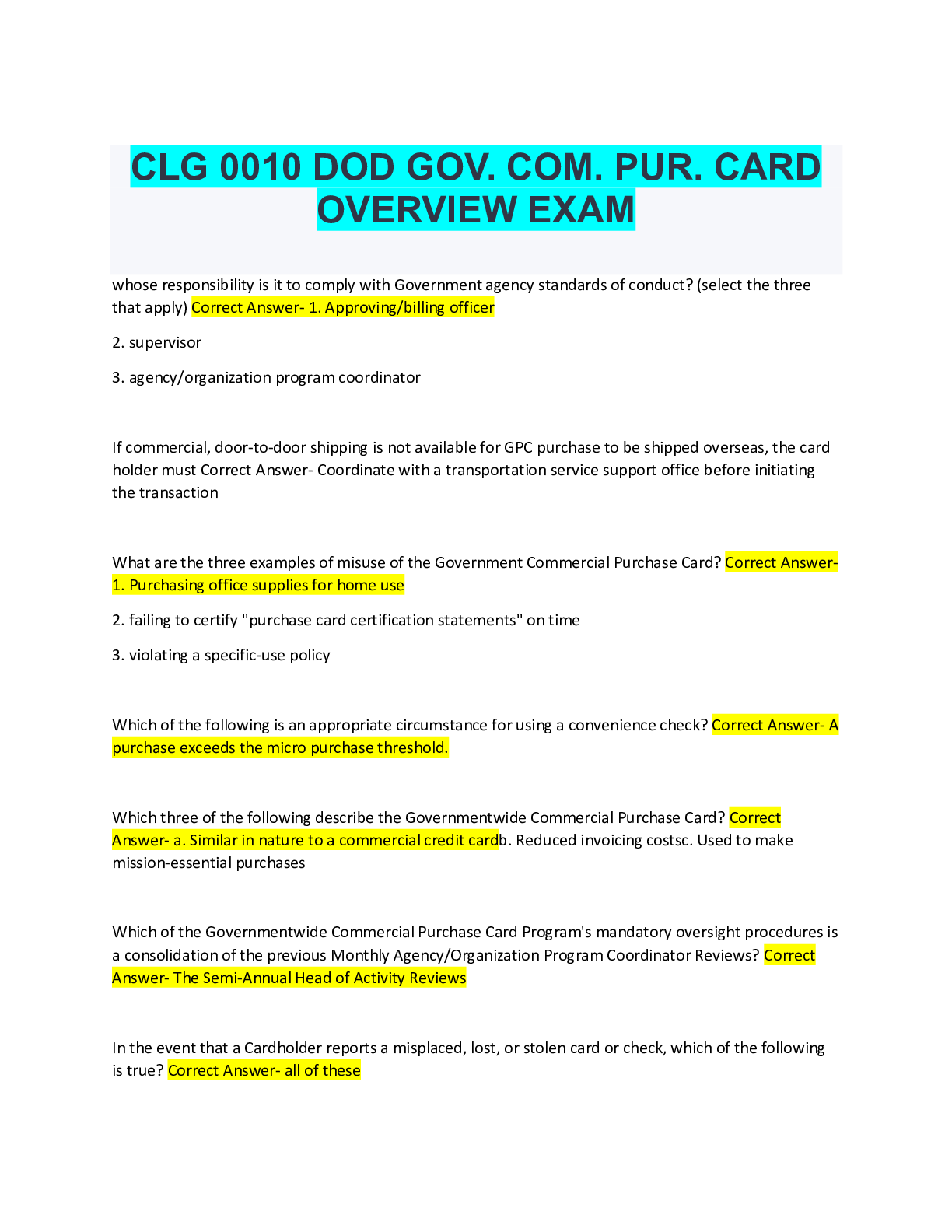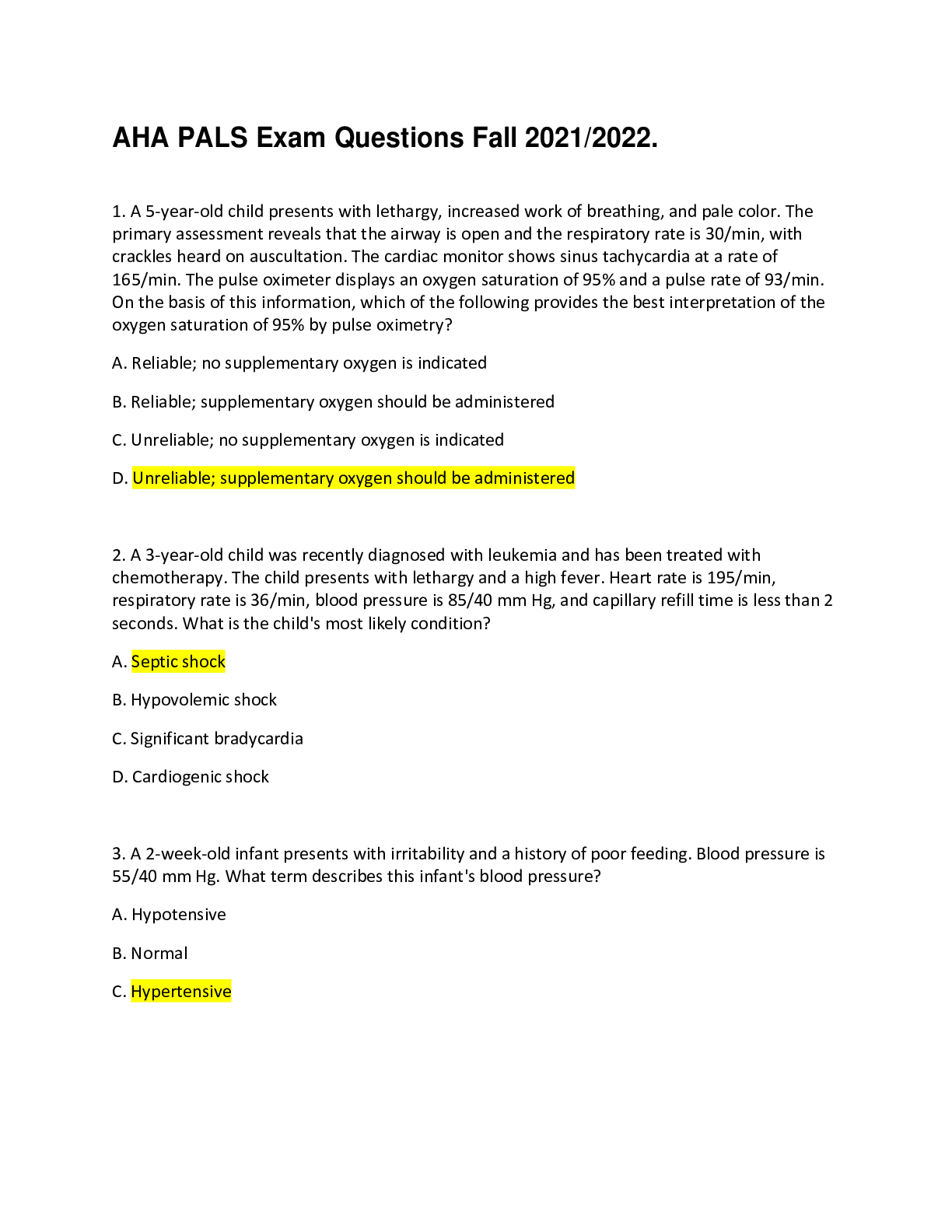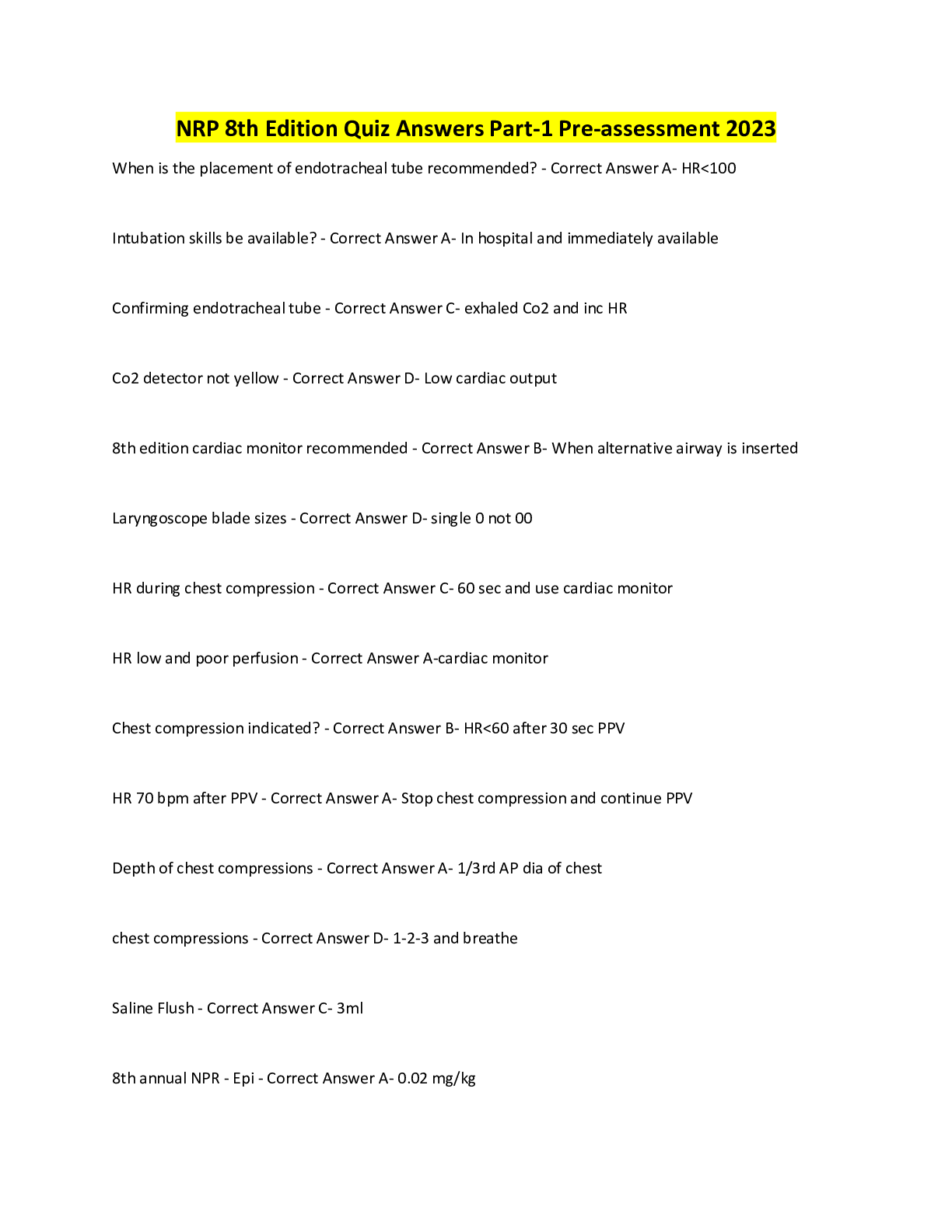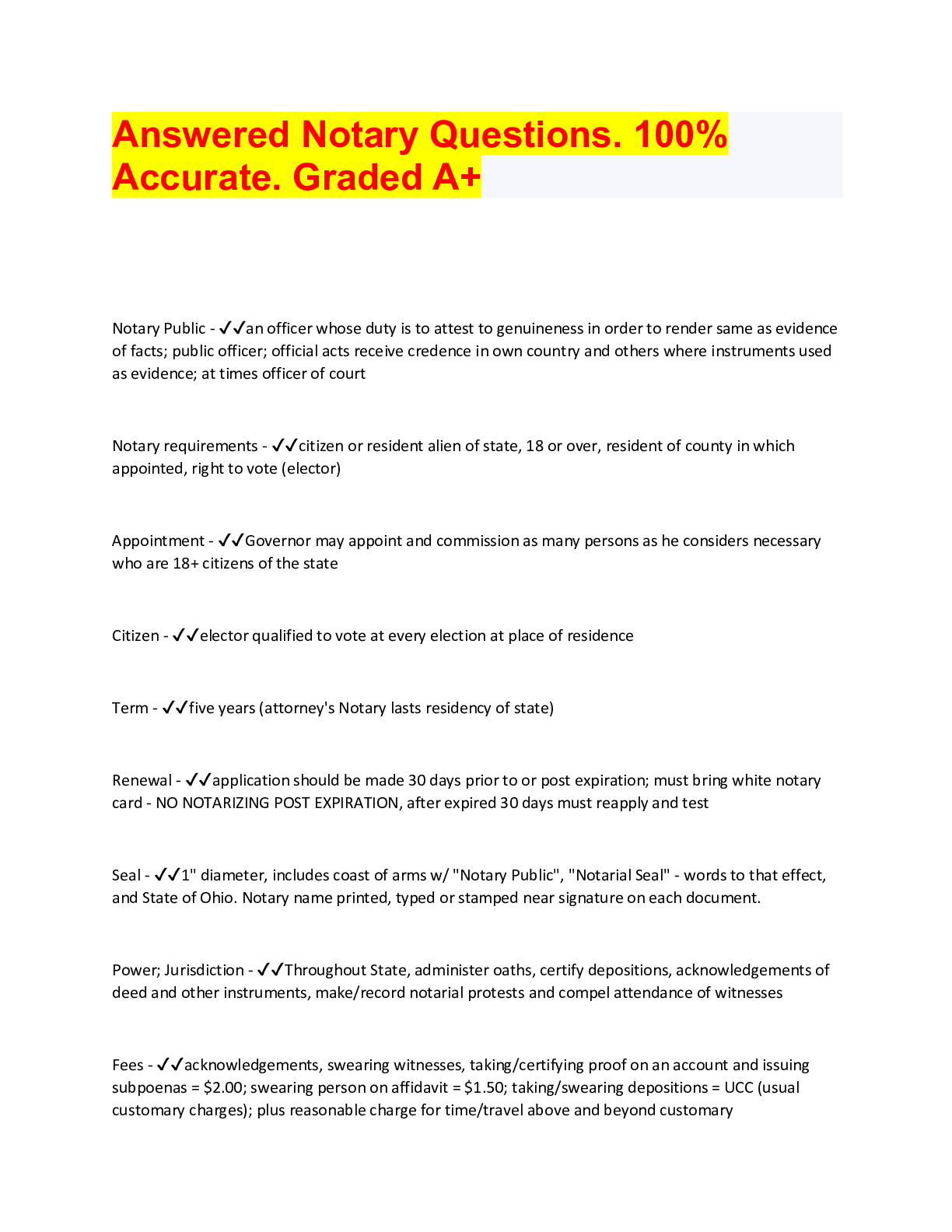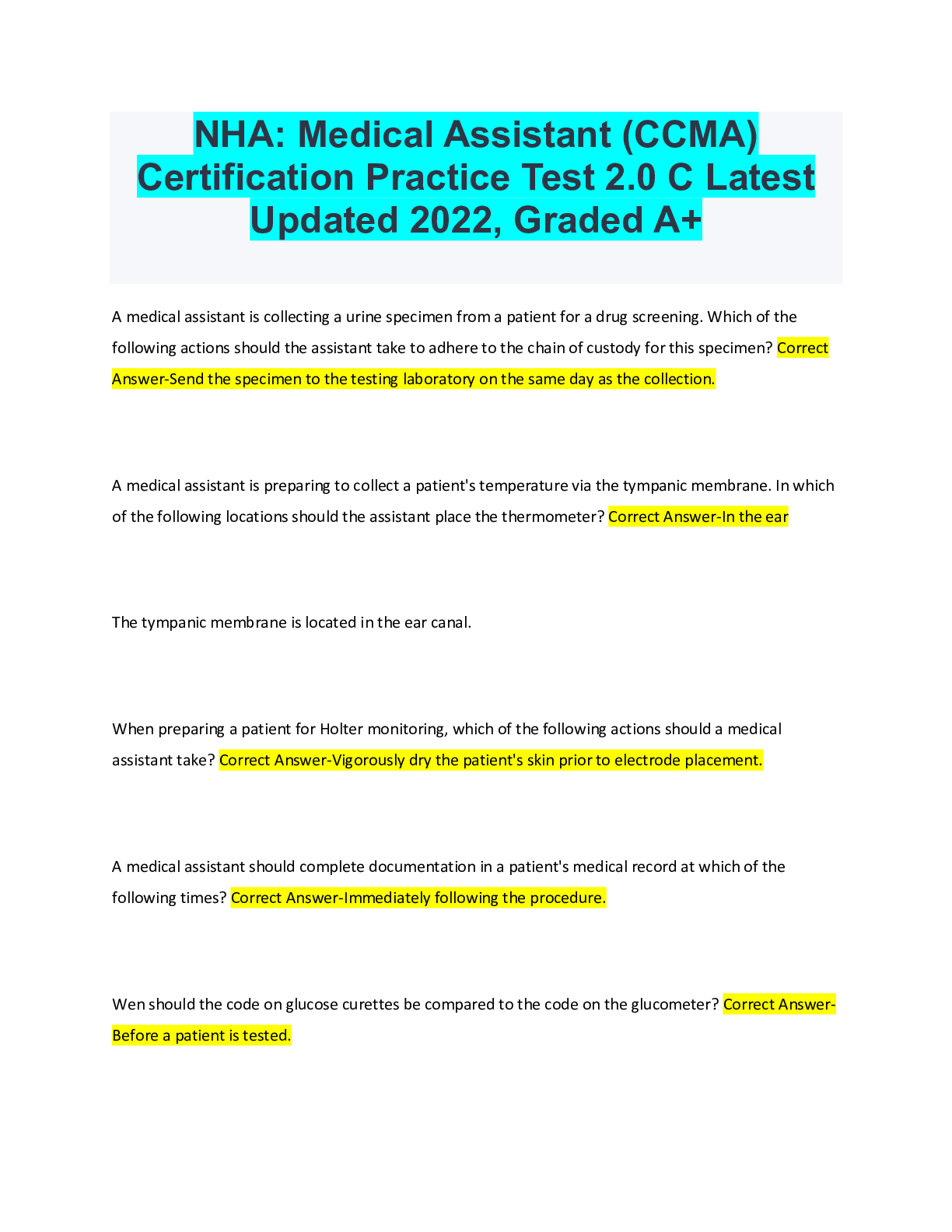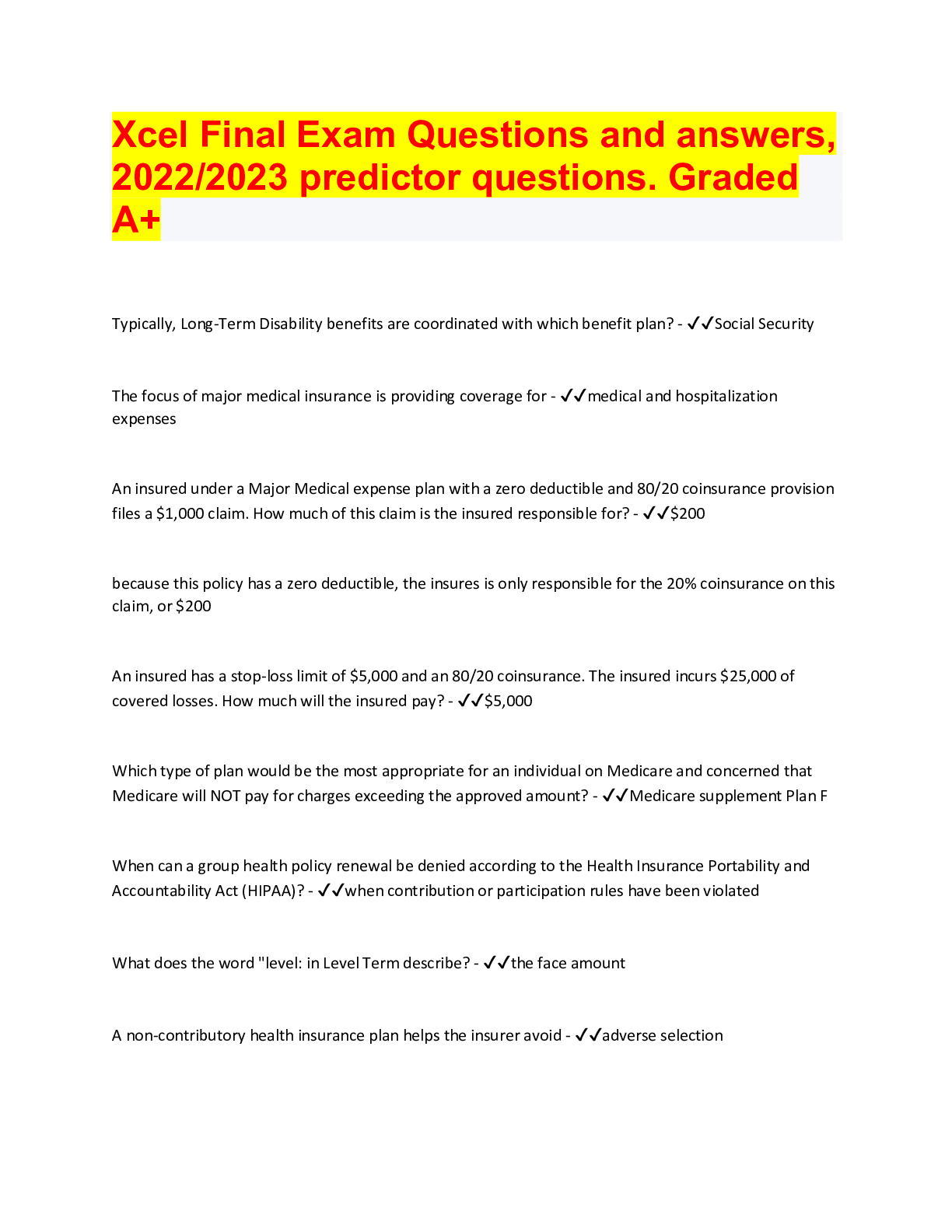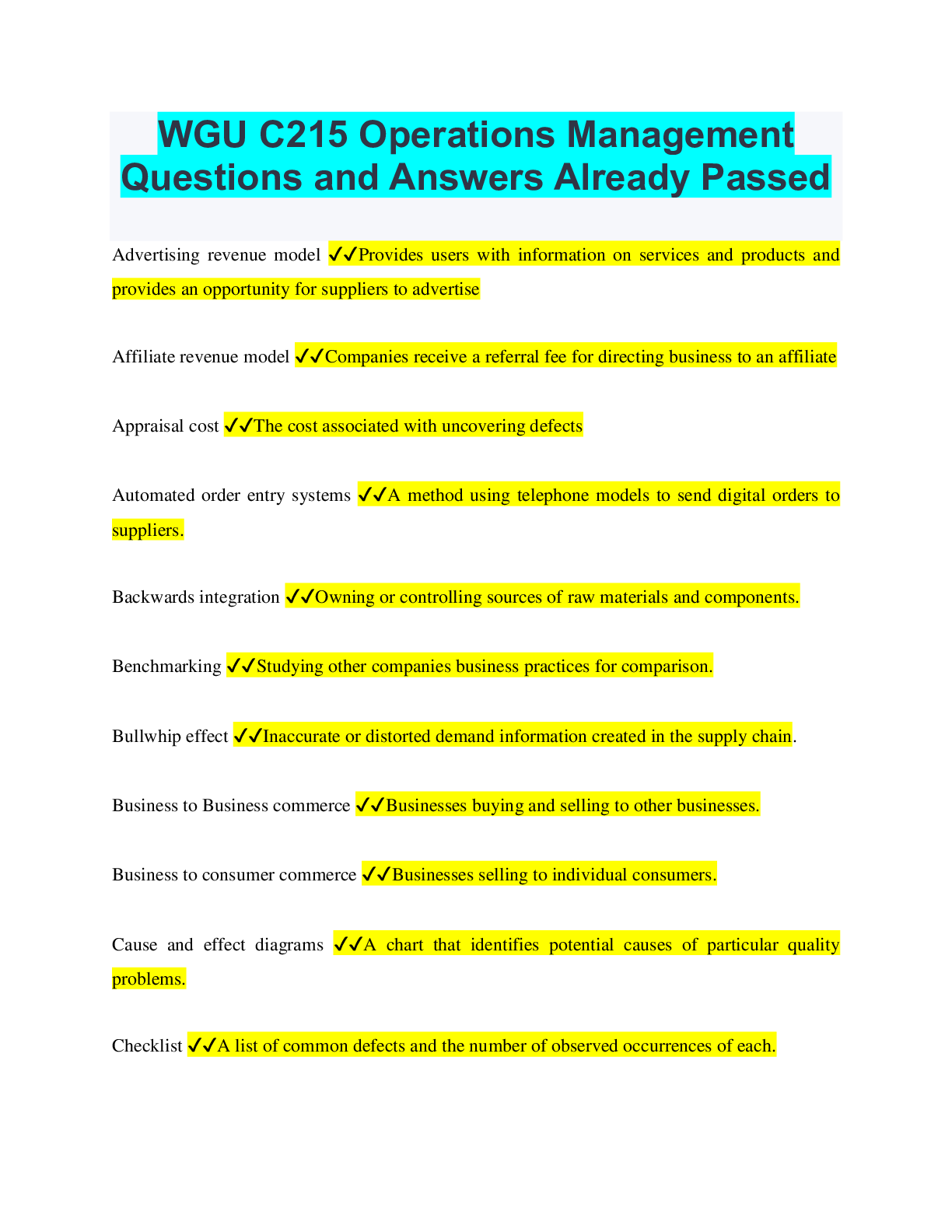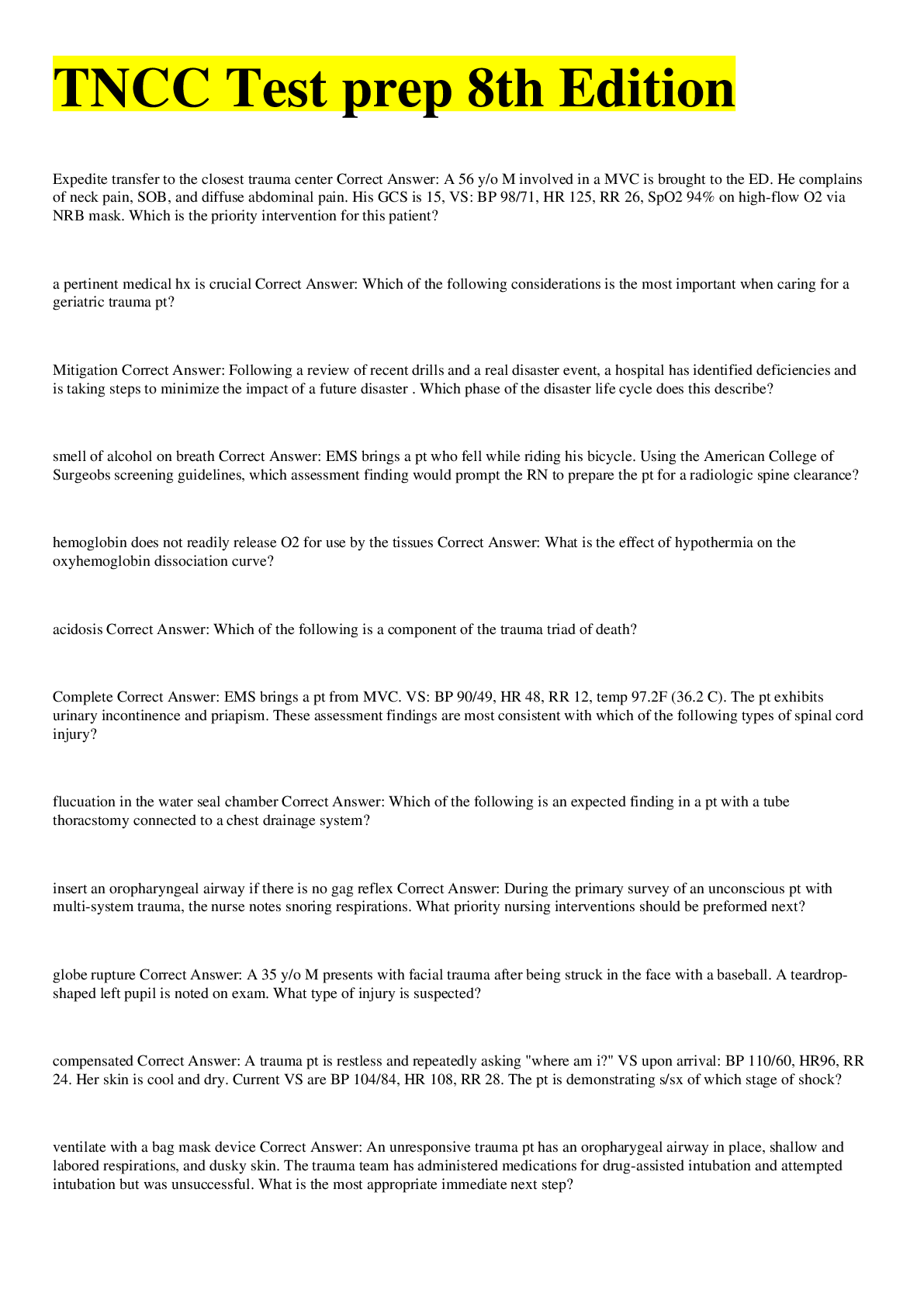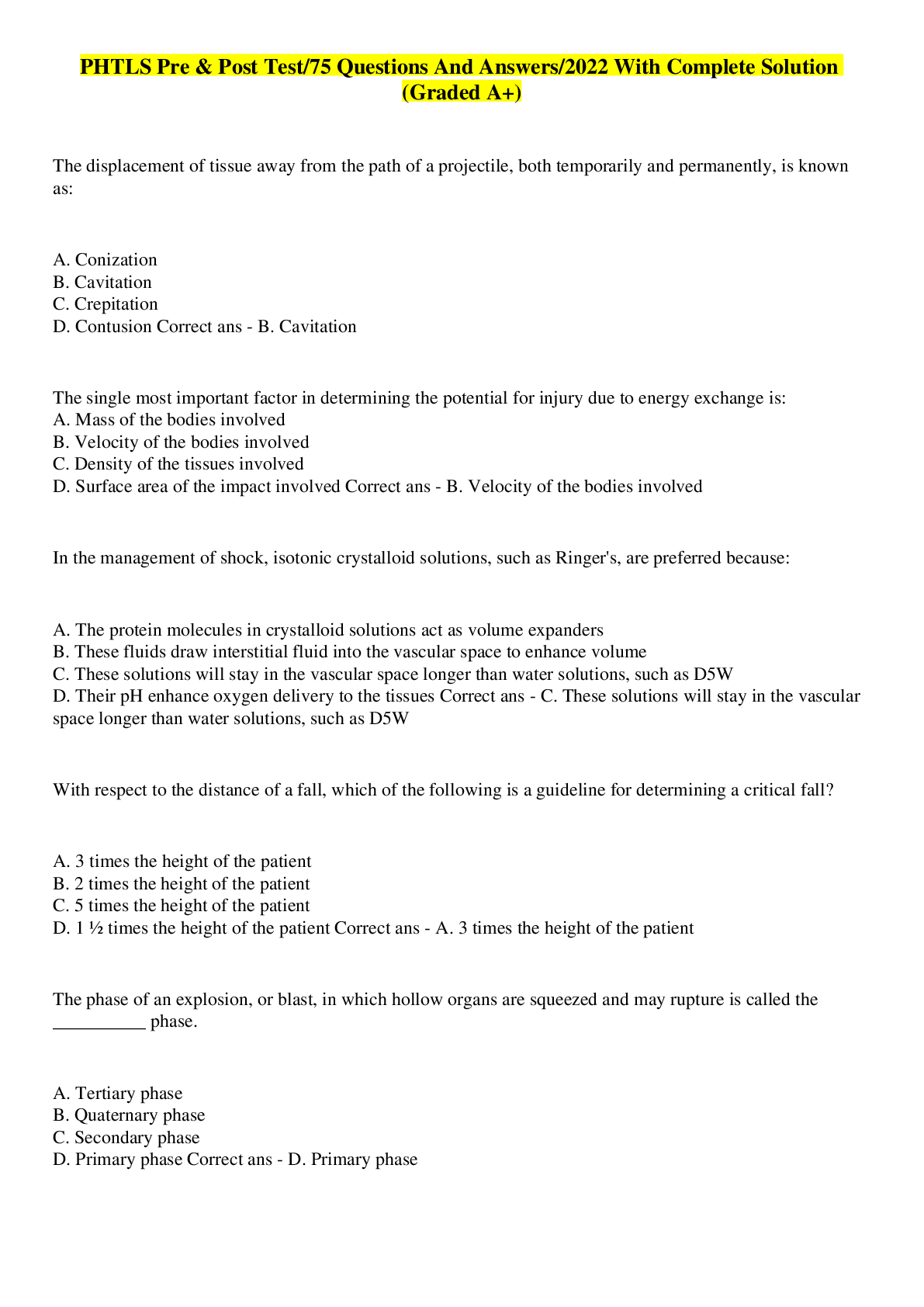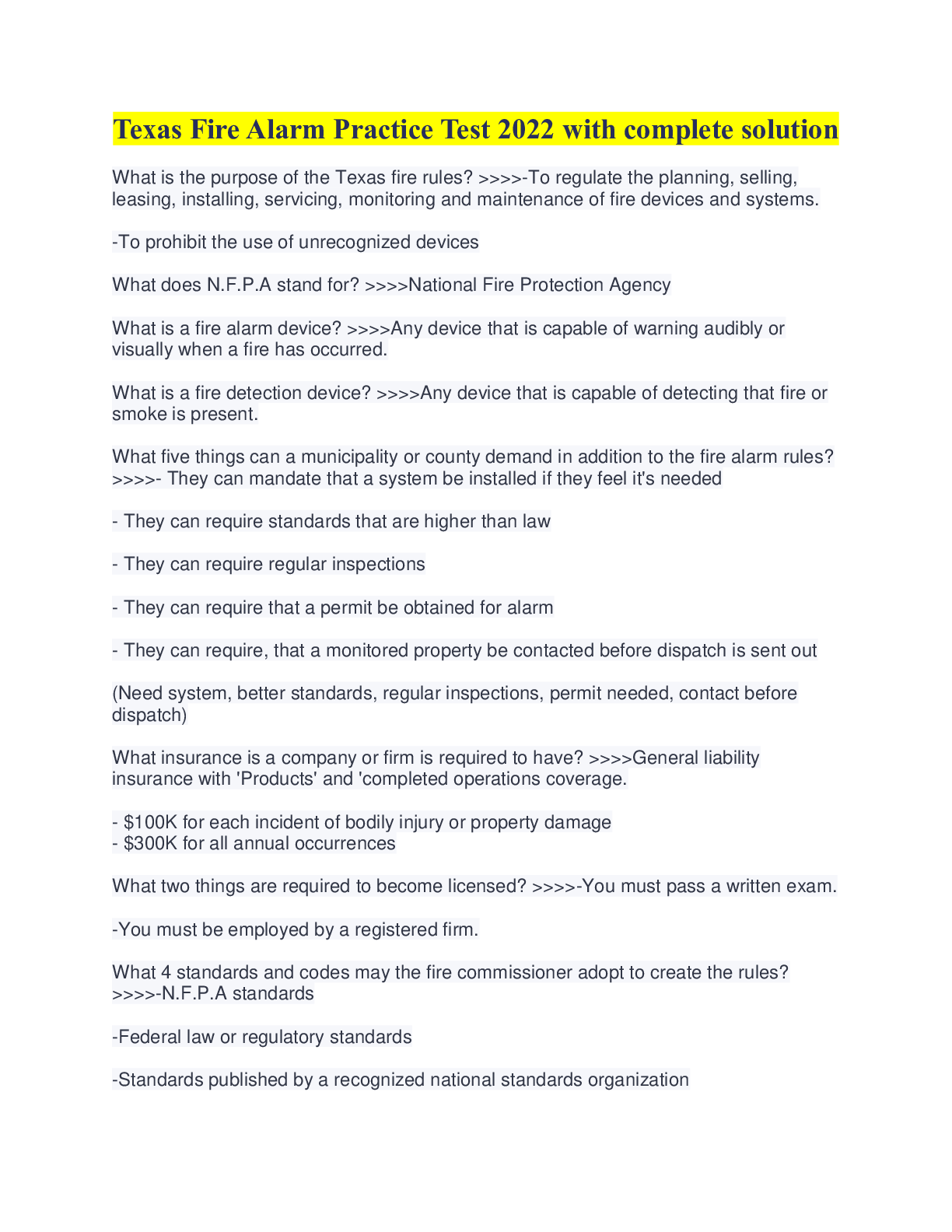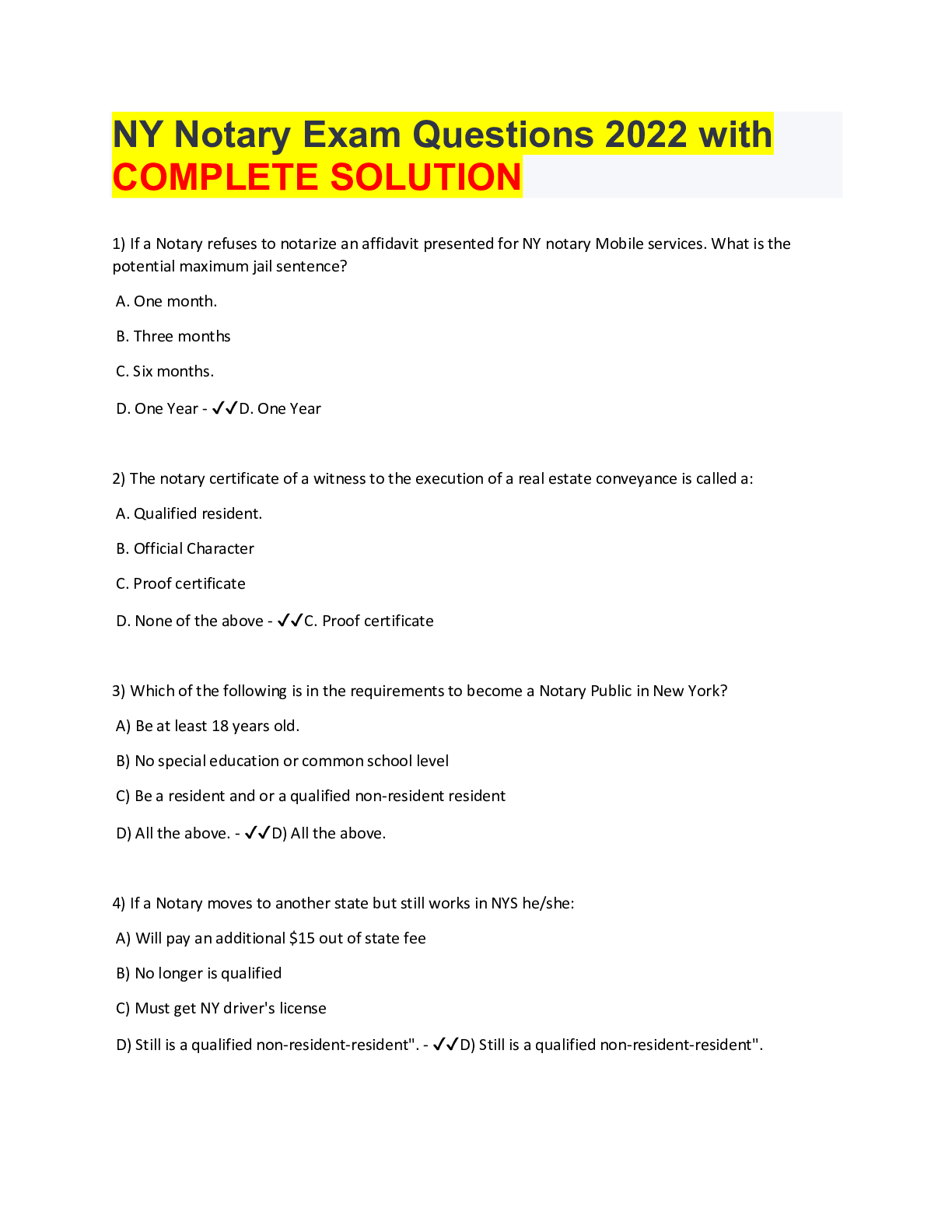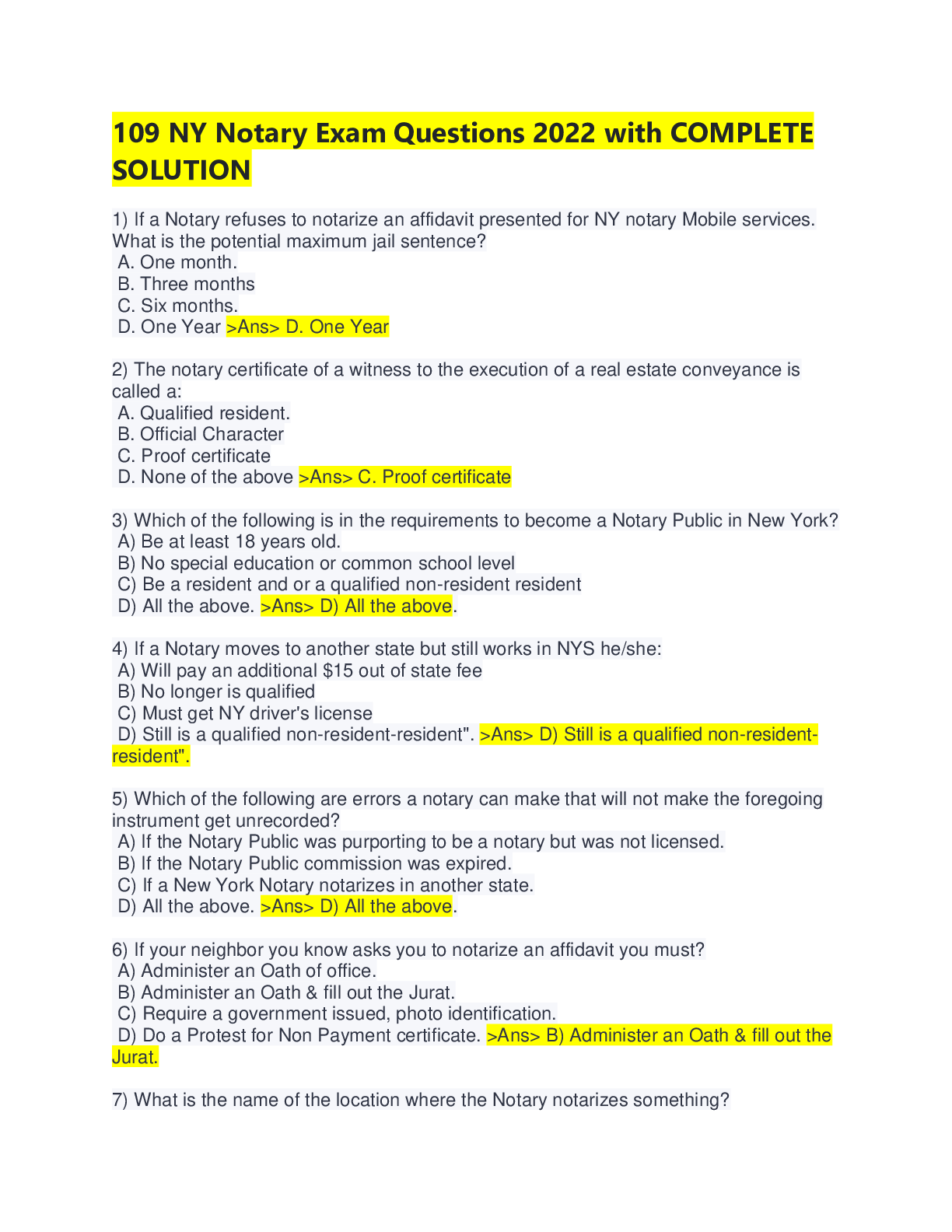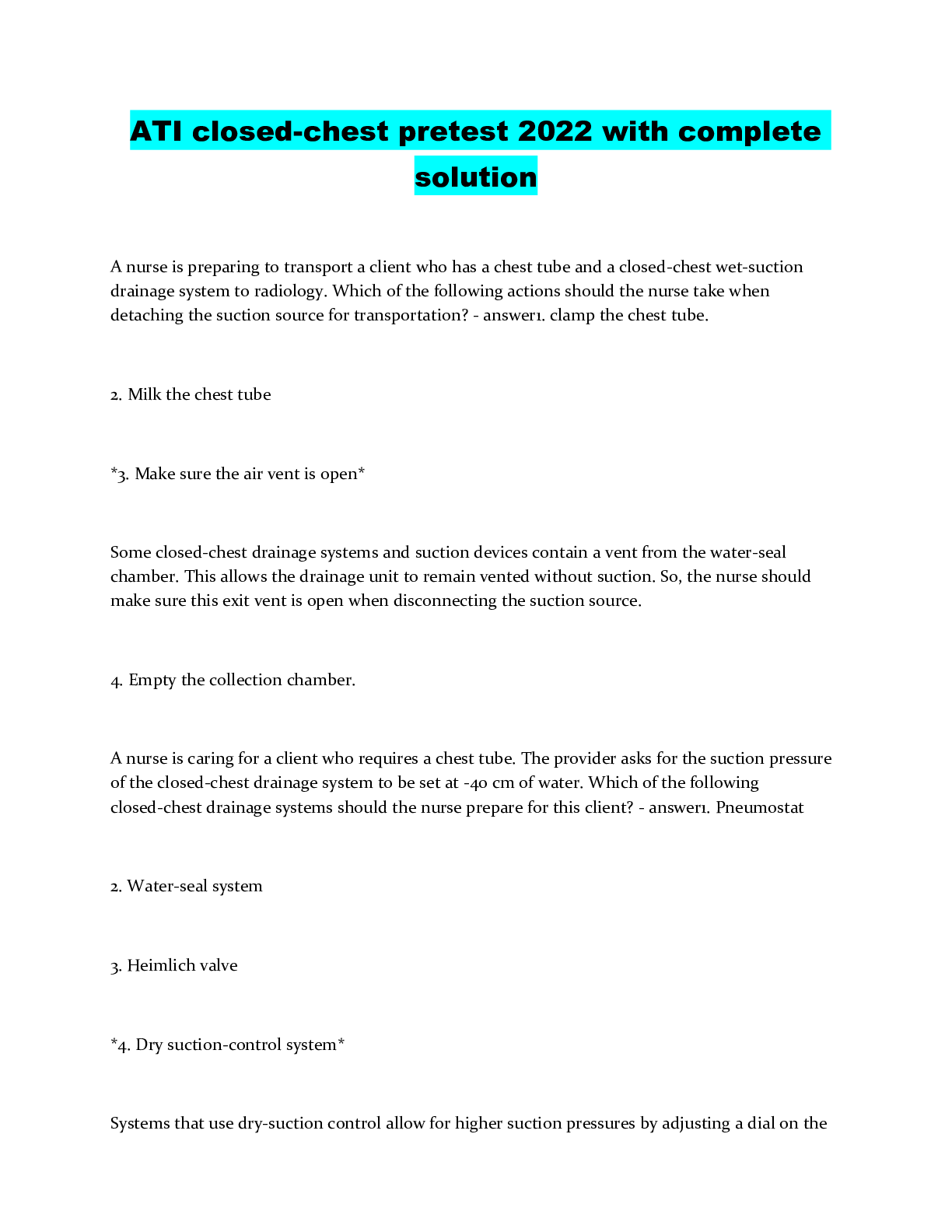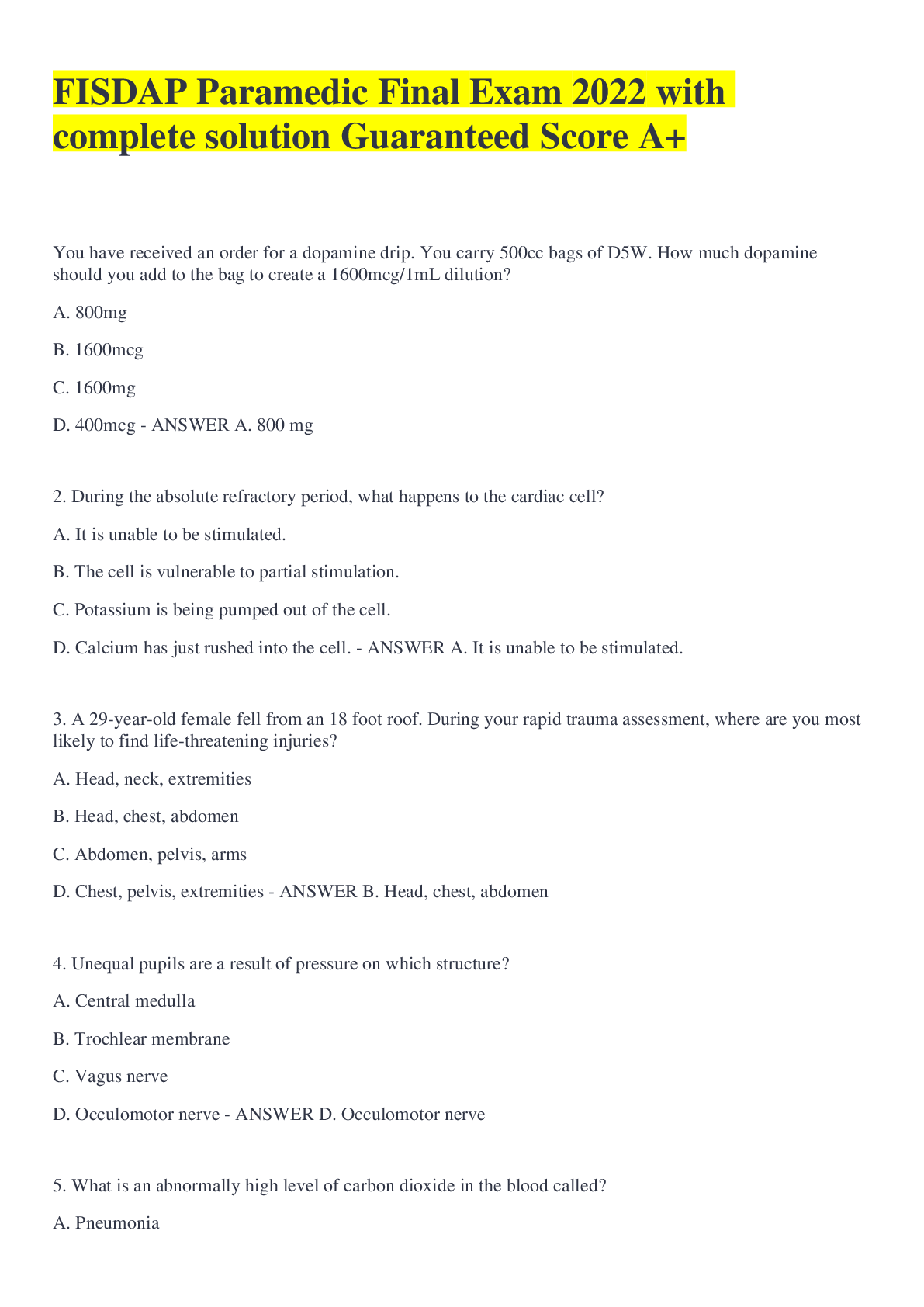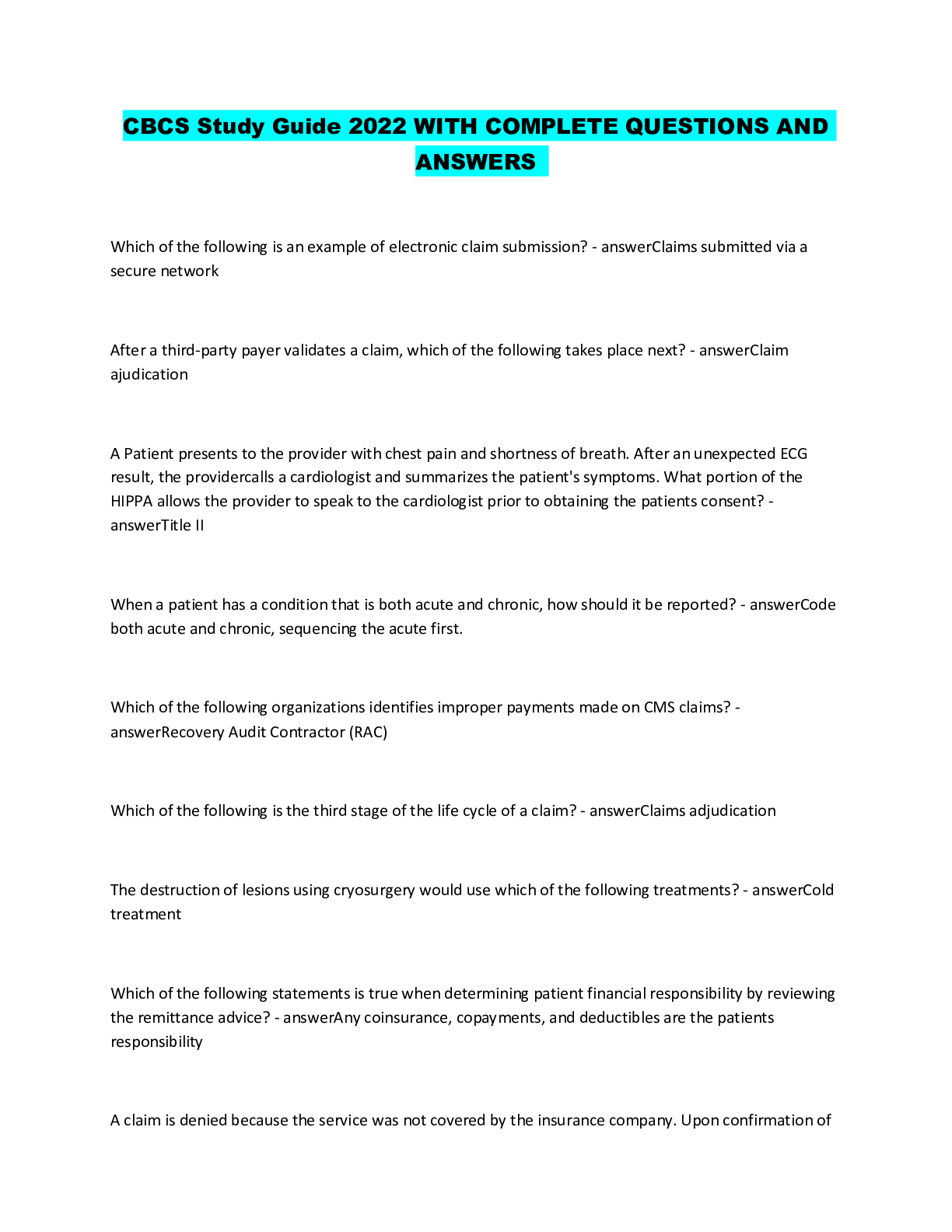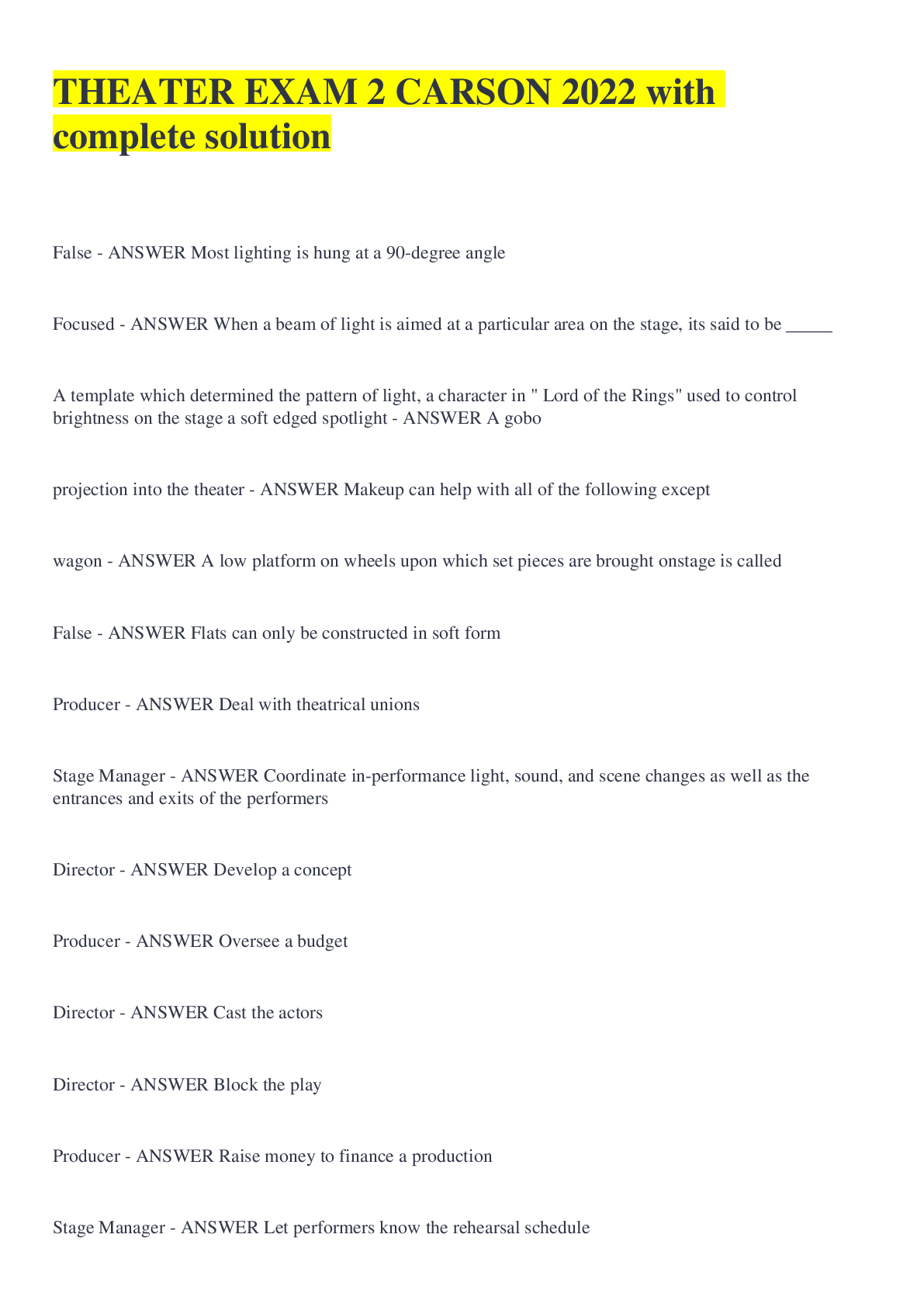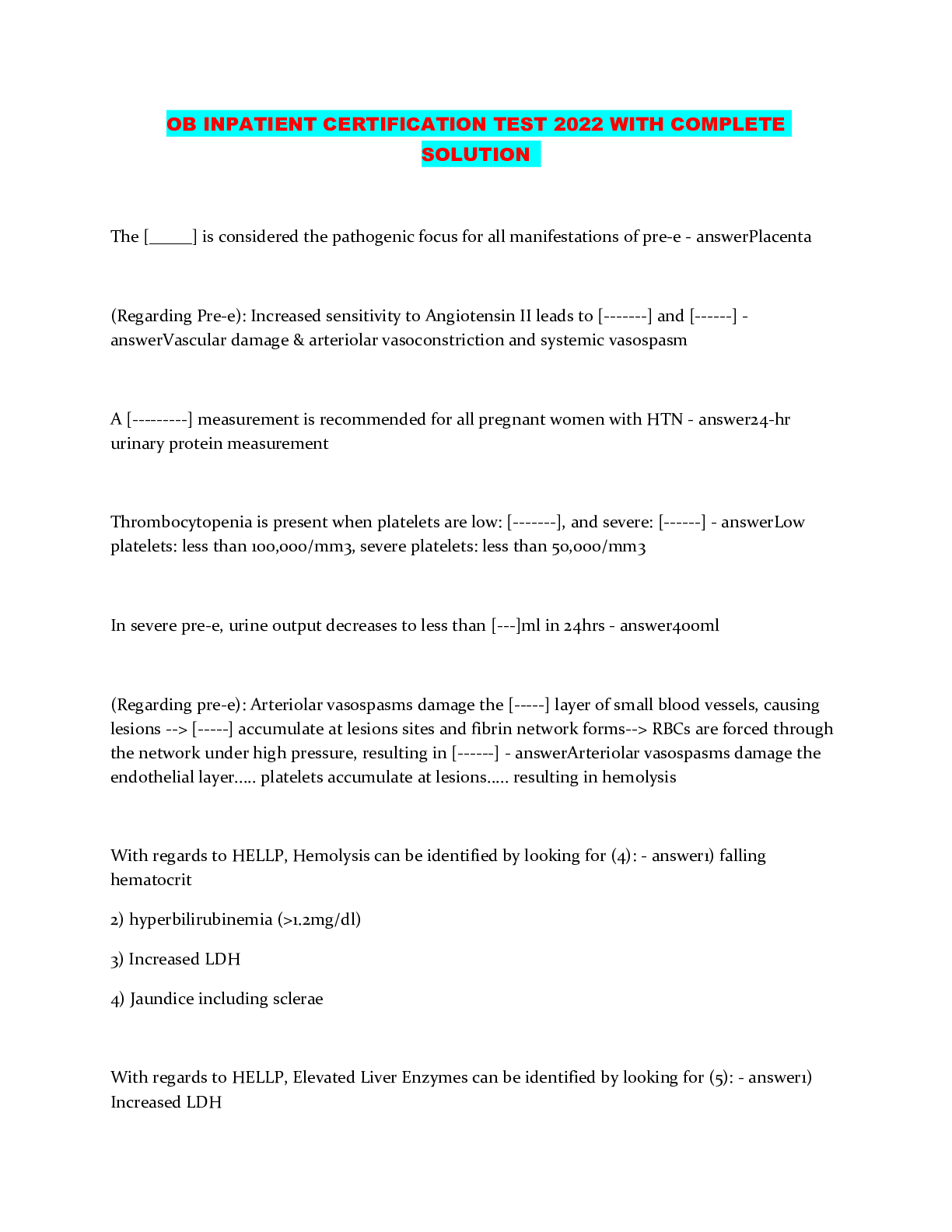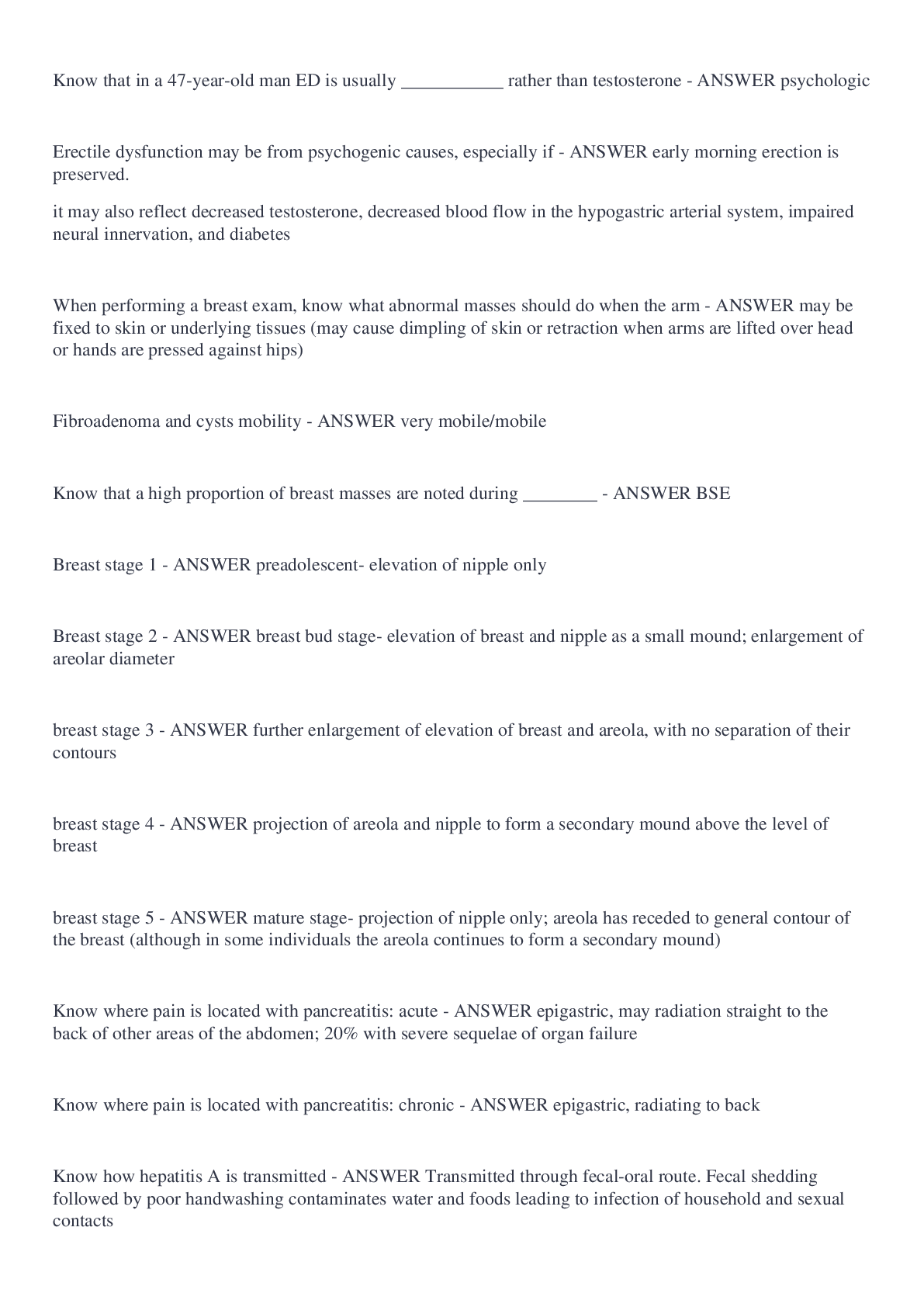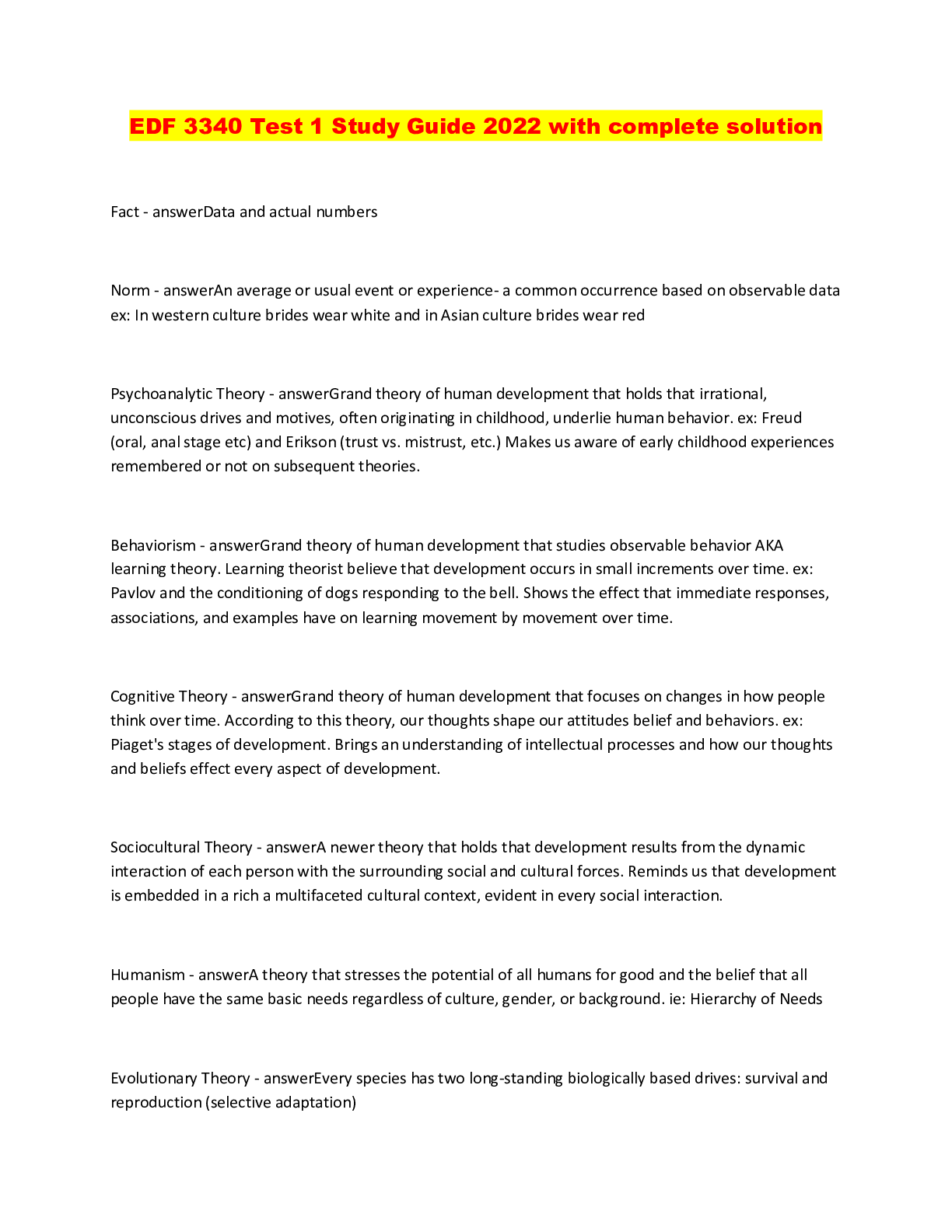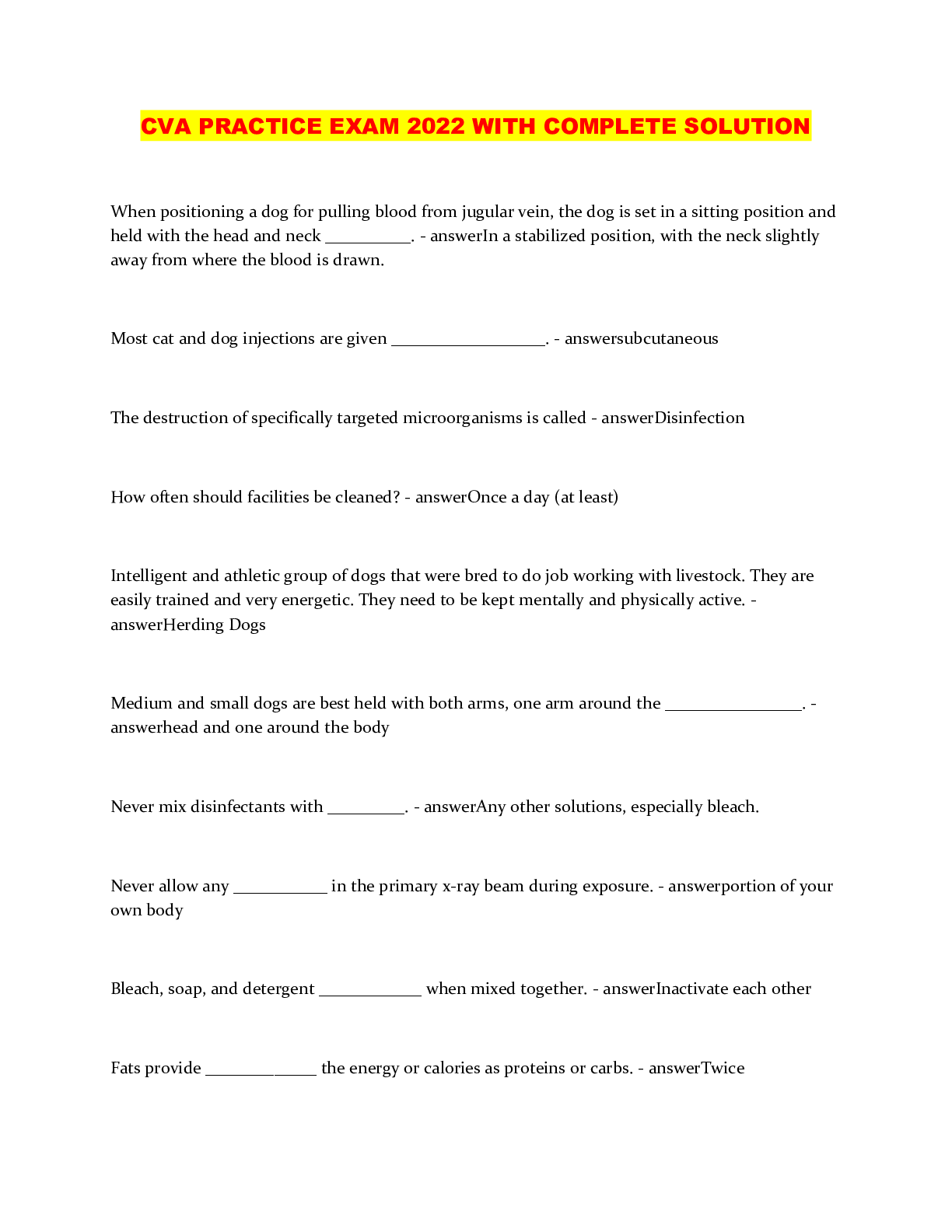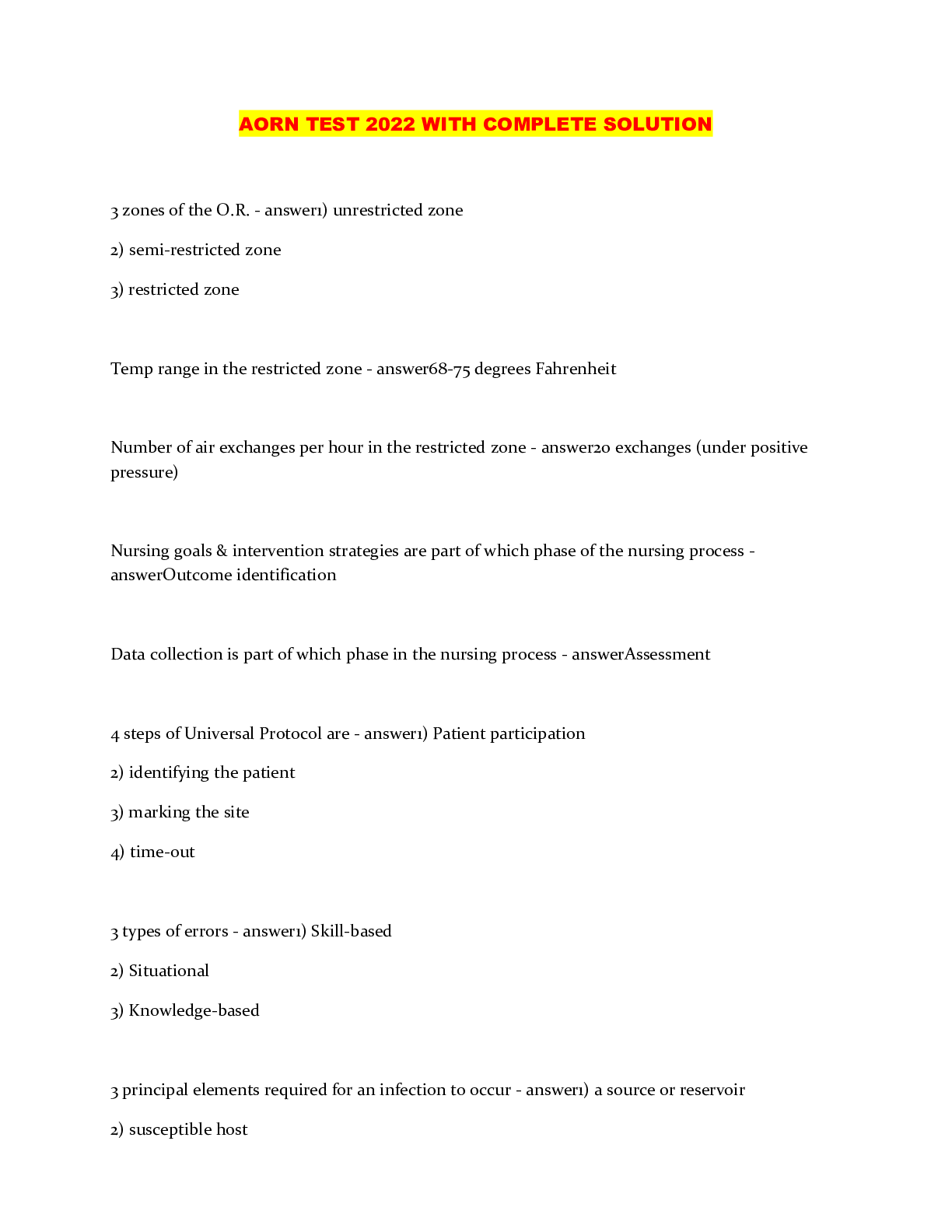*NURSING > QUESTIONS & ANSWERS > ACSM Personal Trainer Certification Exam 2022 with complete solution (All)
ACSM Personal Trainer Certification Exam 2022 with complete solution
Document Content and Description Below
ACSM Personal Trainer Certification Exam 2022 with complete solution ADL -Answer- One's ability to perform daily tasks such as self care and chores. Acroymn Physical Activity -Answer- Transition f... rom rest to active movement Exercise -Answer- Planned and structured physical activity to improve one or more of the 5 components of fitness 5 Components of Fitness -Answer- 1. Cardiorespiratory Endurance 2. Muscle Endurance 3. Muscle Strength 4. Flexibility 5. Body Composition Fitness Conditioning -Answer- Health Related: Focuses on enhancing QoL, preventing disease, moderate-intensity PA Fitness Conditioning: Focuses on exercise regimens based on recommendations for improving fitness SAID -Answer- In order to improve the goal, you must practice the goal. Ex. If the goal is a 5K, you must run to train for it Rate of Remodeling -Answer- Remodel > Damage --> increase training effort Damage > Remodel --> decrease training effort (or may cause overuse/injury) Over Training -Answer- Injury, inc resting HR, fatigued throughout day, low performance FITT-VP -Answer- Frequency (how often) Intensity (how hard) Time (duration) Type (mode) Volume (overall amount) Progression (how to advance) ATP-CP (Phosphagen) System -Answer- Transfers high energy phosphate from Creatine Phosphate to rephyosphorylate ATP from ADP using the enzyme creatine kinase. Anaerobic 0-30 sec high intensity work sprints, weight lifting ADP+CP --Creatine kinase--> ATP+CAnaerobic Glycolysis (Lactic Acid) -Answer- The rapid breakdown of carbohydrate molecules,either glycogen or glucose, occuring without the presence of oxygen. Anaerobic Glucose & lactic acid :30-3 mins high intensity work 400-800m sprint, 100m swim Oxidation System -Answer- Metabolic pathway that can use fat, protien, and carbohydrate as substrates to produce ATP. Fat oxidation 3+ minutes important for endurance capacity limited by O2 and Cals available *Unfit client has decreased ability to deliver O2 from dec capillary density preventing delivery O2 Physiological Adaptations -Answer- 1. Oxygen Deficit - initial stages of CV training bout referred to as lag in O2 consumption, relying on anaerobic metabolism 2. Steady State - achieved w/ sustained CV once O2 supplied equals O2 demanded. Inc fit, reach SS faster and endurance depends how long you stay here. 3. EPOC - O2 debt, uptake remained elevated post exercise for several minutes (or house if longer bout); EPOC effect is to restore CP/ATP in muscles and O2 in blood; "after burn" effect Oxygen Deficit -Answer- Initial stages of CV training bout referred to as lag in O2 consumption, relying on anaerobic metabolism Steady state -Answer- Achieved w/ sustained CV once O2 supplied equals O2 demanded. Inc fit, reach faster and endurance depends how long you stay here. EPOC (Excess Postexercise Oxygen Consumption) -Answer- O2 debt, uptake remained elevated post exercise for several minutes (or house if longer bout); Effect is to restore CP/ATP in muscles and O2 in blood; "after burn" effect Sino Atrial Node -Answer- Pacemaker of the heart, in RA, initiates contraction Atrioventricular Node -Answer- Slows down the heart contracting Right Chambers -Answer- RA receives deoxy blood from vena cava. Blood travels to RV through tricuspid valve. Leaves RV via pulmonary semilunar valve to pulmonary system. Left Chambers -Answer- LA receives oxy blood from veins. Travels to LV through bicuspid valve then to aorta through the aortic semilunar valve where it then travels through the body's arteries to deliver oxygen.Pulse Sights -Answer- Carotid (not recommended to perform on someone) Brachial Femoral Radial (most recommended) Heart Rate -Answer- Avg is 72bpm resting (normal is 60-100bpm) Good gauge for clients to see how fit they are becoming Tachycardia/Bradychardia -Answer- Faster than normal heart rate, >100 bpm Slower than normal heart rate, < 60 bpm Stroke Volume (SV) -Answer- The amount of blood pumped from the left ventricle in one beat Cardiac Output (CO) -Answer- The amount of blood pumped from the heart in one minute Arteriovenous Oxygen Difference -Answer- Difference between oxygen content of arterial and venous blood Pulmonary Ventilation -Answer- Volume of air exchanged per minute VO2 Max -Answer- Highest rate and amount of O2 achieved at maximal physical exertion Acute CR Response (to Aerobic Exercise) -Answer- Increase: HR, SV, CO, AOD, BF, systolic BP, pulmonary ventilation, O2 consumption Chronic CR Adaptations (to Aerobic Exercise) -Answer- Decrease: RHR, BP, blood lactate Increase: SV, Cardiac Output, maximal oxygen consumption Synovial Joints -Answer- Freely movable allowing for variety of angular, circular, and specialized movements; most common type in human body Cardiac Muscle -Answer- involuntary muscle tissue Smooth Muscle -Answer- involuntary muscle tissue of arterial walls and organs of the body Skeletal Muscle -Answer- Voluntary muscle tissue made of striated fibers Type I Fibers -Answer- Aerobic, slow twitch, slow oxidative, red twitch Type IIA Fibers -Answer- Aerobic and anaerobic capabilities, intermediate fibers, fast oxidative glycolitic fibersType IIB Fibers -Answer- Anaerobic fibers, fast glycolitic, white twitch fibers Acute Responses to Training -Answer- Increase HR and BP, SV (eccentric). short term Chronic Responses to Training -Answer- Hypertrophy, hyperplasia, muscle fiber transformation, increase in connective tissue. Hypertrophy -Answer- Increase in muscle size Hyperplasia -Answer- Increase in number of cells Acute Muscle Injuries -Answer- Contusions/bruises, muscle strains, AOMS, DOMS, joint subluxation/dislocation, ligament sprains Overuse Muscle Injuries -Answer- tonditis, fasciitis, bursitis, osteoarthritis, shin splints, patello-femoral pain RICE -Answer- Rest, Ice, Compression, Elevation, (Stabilization) Angina (symtoms) -Answer- Chest pain and pressure, radiating jaw pain, shortness of breath, subscapular pain Heat Exhaustion -Answer- Cool, moist, pale or flushed skin, dizziness, weakness, heavy sweating, body temperature near normal Heat Stroke -Answer- Red, hot, dry skin, rapid weak pulse, changes in level of consciousness, vomiting, body temperature as high as 105F Hydration Recommendation -Answer- 16 fl. oz water for every lb lost during exercise Antihypertensive Medication -Answer- Reduces high BP, can cause reduced BP in exercise Psychotropic Medication -Answer- Medication that can slow down metabolism Beta-Blocker Medication -Answer- Reduces resting and exercise HR and BP Caffeine as Erg. Aid -Answer- May extend endurance in moderate aerobic exercises, mobilizes FFA into blood stream 1st Class Lever -Answer- Primarily for balance, see saw Ex. Head on cervical vertebrae 2nd Class Lever -Answer- Primarily for power Wheel barrowEx. Plantar flexion while walking 3rd Class Lever -Answer- Primarily for ROM, always physiological disadvantaging movement, distance between lever and fulcrum is smallest; 75% of skeletal system Ex. Shoveling motion Elbow flexion Lever-Pulley-Fulcrum -Answer- Bones-Muscles-Joints Sagittal Plane -Answer- Divides body into left and right segments Flexion/extension movements Frontal Plane -Answer- Divides body into anterior and posterior segments Abduction/adduction movements, some fl/ex Transverse Plane -Answer- Divides body into superior and inferior segments Ab/adduction along horizon Chest, traps, upper back, obliques Also known as the horizontal plane Supine/prone -Answer- Face up/face down Anterior/posterior -Answer- Front/back Proximal/distal -Answer- Closer to trunk/further from trunk (anatomical position) Superior/inferior -Answer- Above/below Valgus/varus -Answer- Distal segment of joint deviates laterally/medially Abduction/adduction -Answer- Movement away from/into the midline Flexion/extension -Answer- Decrease/increase in joint angle Lateral flexion -Answer- Decrease in joint angle (spine and side bend) Hyperextension -Answer- Extension beyond normal degree of extension Supination/pronation -Answer- Lateral/medial rotation of forearm Plantar flexion/dorsiflexion -Answer- Extension/flexion of the ankle Retraction/protraction -Answer- Scapula toward (adduction) or away from midline (abduction) Inversion/eversion -Answer- Movement of foot medially and laterally (intertarsal)Internal/external rotation -Answer- Transverse plane rotation toward/away from midline Elevation/depression -Answer- Shoulder girdle movement upward/downward Circumduction -Answer- Moving in a 360 degree arc/multiplanar Isometric Contraction -Answer- Static tension is created within the muscle fiber but it does not change in length so no joint angle change, NO WORK is done, F=R Ex. Wall sit, plank, lunge hold Isotonic Contraction -Answer- Dynamic, muscle fibers change in length and joint angle changes, WORK is done (W=f*d); may be concentric or eccentric Concentric -Answer- Muscle fibers creating cross bridges while shortening in length against the pull of gravity so F>R Positive movements, prime movers Eccentric -Answer- Muscle fibers creating cross bridges while lengthening to resting length while going with direction of gravity (F<R) Negative movements, direction to stretch the prime mover muscle Isokinetic -Answer- Variable force with consistant speed Ex. Rower Bench press -Answer- Movement Horizontal Shoulder Adduction (pec major, ant. deltoid) Elbow Extension (triceps) Cable seated row -Answer- Movement Scapula adduction (trapezius mid) Shoulder hyperextension (latissimus dorsi) Elbow flexion (biceps) Shrugs -Answer- Movement Shoulder girdle elevation (trapezius upper) Cable pull down -Answer- Movement Shoulder adduction (lat dorsi) Elbow flexion (biceps) Back extension -Answer- Spinal extension (erector spinae) Abdominal curl -Answer- Spinal flexion (rectus abdominus) Oblique twist -Answer- Spinal rotation/flexion (internal/external obliques)Overhead shoulder press -Answer- Shoulder abduction (deltoids) Elbow extension (triceps) Rotator cuff exercises -Answer- Shoulder abduction (supraspinatus) External rotation (infrapinatus and teres minor) Internal rotation (subscapularis) Lateral raise -Answer- Shoulder abduction (deltoid) Bar squat -Answer- Hip extension (hamstrings, glutes) Knee extension (quadriceps) Leg extension-seated -Answer- Knee extension (quadriceps) Prone leg curl -Answer- Knee flexion (hamstrings) Standing calf raise -Answer- Plantarflexion (gastrocnemius) Seated toe raise -Answer- Dorsiflexion (Tibialias anterior) Erector spinae -Answer- Location: Spine Extension/hyperextension Lateral flexion, rotation Supinator -Answer- Joint: Wrist Supination Pronator teres -Answer- Joint: Wrist Pronation Adductor muscle group -Answer- Joint: Hip Adduction (magnus, brevis, longus) Gluteus medius -Answer- Joint: Hip Abduction Medial rotation (+ glut minimus) Gluteus maximus -Answer- Joint: Hip Extension and hyperextension (w/hamstring) Lateral rotation (+ Obturator) Iliopsoas -Answer- Joint: Hip Flexion (w/rec femoris) Rectus femoris -Answer- Joint: HipFlexion (w/iliopsoas) Gastrocnemius -Answer- Joint: Ankle Plantarflexion (+ soleus) Tibialis -Answer- Joint: Ankle (anterior only) Dorsiflexion (w/peroneus tertius) Joint: Intertarsal (anterior and posterior) Inversion Peroneus tertius -Answer- Joint: Ankle Dorsiflexion (w/tib anterior) Peroneals -Answer- Location: Foot Eversion Exercise Response -Answer- Significant improvements in fitness measures early in training program; active individuals will notice smaller improvements with similar increases in training intensity Flexibility Training -Answer- Reduce muscle tension, smoother muscle contractions, improves ease of movement, decreases DOMS, prevents muscle tendon shortening that results from inactivity, muscluar asymmetry, age, and disease Progressive Resistance Training -Answer- Training style referring to the need to increase amount of stress to the muscle as they increase in strength Benefits of RT -Answer- Stress mgmt, increase physical capacity, injury prevention/rehab, osteoporosis mgmt and prevention, maintenance of fat free weight MES -Answer- Minimal essential strain Remodels bone, prevents/manages osteoporosis SMART Goals -Answer- Specific, Measurable, Action-based, Realistic, Timely Stress (defined) -Answer- Non specific response of the body to any demand made on it Stressor (defined) -Answer- A demand or event that initiates the stress response; can be social psychological, psychosocial, and physical Personal Stressors -Answer- (related to exercise dropout) inactive leisure time and occupation, smoking, overweight, blue collar worker Socioecological Model -Answer- Viewing client within a larger social framework to determine health behaviors; address--Individual: knowledge, skills, attitude Interpersonal: social network Schools: environment Community: cultural values, norms Public policy TTM Stages of Change -Answer- Pre-contemplation: not ready to exercise, not interested Contemplation: Thinking about making changes Preparation: Doing something related to exercise but not meeting guidelines Action: Meeting set criteria <6 months (still susceptible to dropout) Maintenance: Meeting criteria >6 months Social Cognitive Theory -Answer- Based on individual emotions and personality, past and present; behaviors; environment physically and socially Self Efficacy: belief in their capability to successfully complete a course of action such as exercise (task self vs barrier self, able to do the task vs overcoming barriers like time and fatigue) Theory of Planned Behavior -Answer- Intentions to perform a behavior are the primary determinant, intentions are determined by an individual's attitudes, subjective norms, and perceived control of the outcomes Learning Process Phases -Answer- Cognitive Phase: Learning general skills and concepts Associative Phase: Practice and refine Automatic Phase: Skill is developed and consistent Adult Learning Strategies -Answer- Self directed focus Involvement in decision making Use past experience as a basis of decision making Learn by problem solving Learn best when emotionally and physically stable Intrinsic (from within) or extrinsic (outside) reward system FITT-VP -Answer- Frequency, Intensity, Time, Type, Volume, Pattern, Progression (FITT-VP for) CR Fitness Programming -Answer- F: 3-5 days/wk I: Vigorous/moderate or combination Time: 150min/wk moderate or 75 min/wk vigorous Type: whatever individual enjoys Volume: >500-1000 MET*min/wk or 1000 Cals/wk Pattern: Perform in continuous session per day or multiple sessions to accumulate volume; utilize interval training Progression: Initial 4-6 wks add 5-10 mins every 1-2 wks; after improvement 4-8 months, avoid large increases in FITT components but one may be toleratedHR max equation -Answer- HRmax = (220-age) +/- 10 Intensity of CR Programming -Answer- Deconditioned: 30-40% HRR/VO2 or 57-64% HRmax Fit: 70-90% HRR/VO2 or 84-94% ACSM recommends 64-94% HRmax or 40-90% HRR/VO2 for most people, it is recommended to manipulate time before manipulating intensities Vigorous > 70% HRmax or > 60% HRR Time of CR Programming -Answer- Moderate: 30-60 min/day or 150 min/wk Vigorous: 20-60 min/day or 75 min/wk Or a combination < 20 min/day can be beneficial to sedentary adults Health Benefits of CR Training (ACSM & CDC) -Answer- All adults should accumulate 30+ min of physical activity (moderate intensity) preferably all days of the week ACSM & AHA CR Training -Answer- <65 should engage in moderate intensity aerobic exercises 30 min/day, 5 days/wk or high intensity 20 min/day, 3 days/wk HRrest -Answer- Bpm taken first thing in the morning, averaged over the course of 3 days HRmax -Answer- HR of all out effort, estimated as (220-age)+/- 10 Target Heart Rate -Answer- HR within intensity range during training VO2 Reserve -Answer- O2 Uptake reserve, difference between max and resting O2 uptake Heart Rate Reserve -Answer- Difference between HRrest and HRmax Resting Heart Rate -Answer- Rate the heart recovers from exercise RPE -Answer- Perceived exhaustion scale, 6-20 scale; 12-16 for general public during exercise; adding a 0 estimates HR Karvonen Formula -Answer- HRR = HRmax - HRrest THR = [HRR * training%] + HRrest *Important for HR training, safety, vig vs moderate control METs -Answer- Metebolic Equivalence O2 consumption and caloric expenditure relative to resting values MET (equation) -Answer- 1 MET = [VO2mL(kg*min)^-1]/3.5 --> MET of restEx. 8 METS = metabolic requirements of activity for O2 and energy are 8x that compared to rest Mod ex -Answer- 40% to <60% VO2R; <6 METs "An intensity that causes noticeable increases in HR and breathing" Vig ex -Answer- >60% VO2R; >6 METs "An intensity that causes substantial increases in HR and breathing." Client Physical Readiness -Answer- Poor: Sedentary, no habitual activity, extremely deconditioned Poor-fair: Minimal PA, no exercise, moderately to highly deconditioned Fair-average: Sporadic PA, no/suboptimal exercise, moderately to mildly deconditioned Average-good: Habitual PA, regular moderate/vig exercise Good-excellent: High habitual PA, regular vigorous intensity exercise Aerobic Training for Beginners -Answer- No activity: focus on light to moderate activity for 20-30 mins/day, accumulating 10 min bouts is okay; totaling 60-150 min/week Minimal prior PA: focus 30-60 min/day (accumulating 10 min bouts okay); totaling 150- 200 min/wk Aerobic Training for Intermediate -Answer- Fair-average readiness: moderate 30-90 min/day, accumulating 200-300 min/wk >60 min at a time can increase dropout rate Aerobic Training for Established -Answer- Moderate to vigorous exercise 30-90 min/day, targeting 200-300 min/wk for moderate or 100-1 [Show More]
Last updated: 1 year ago
Preview 1 out of 17 pages
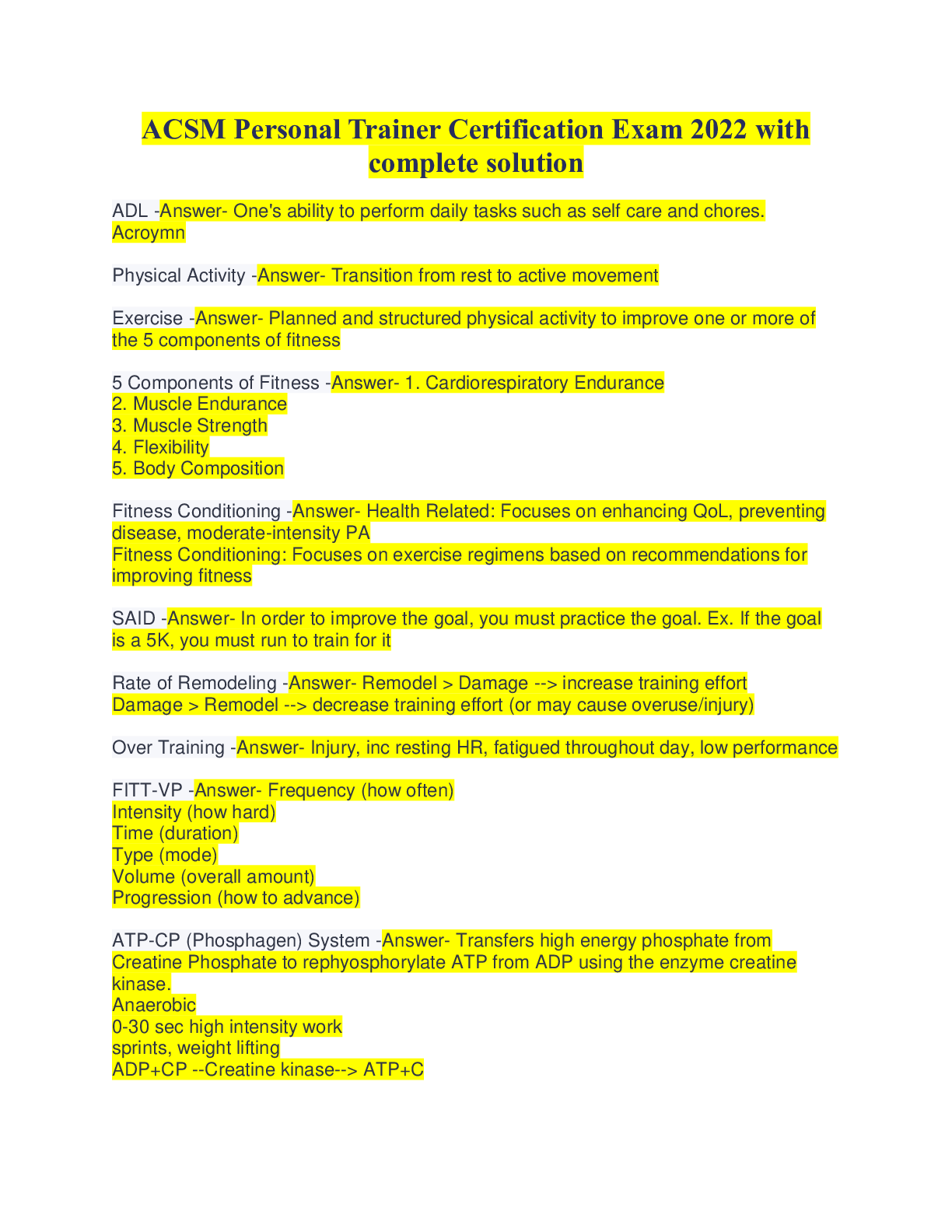
Reviews( 0 )
Document information
Connected school, study & course
About the document
Uploaded On
Jan 10, 2023
Number of pages
17
Written in
Additional information
This document has been written for:
Uploaded
Jan 10, 2023
Downloads
0
Views
99




